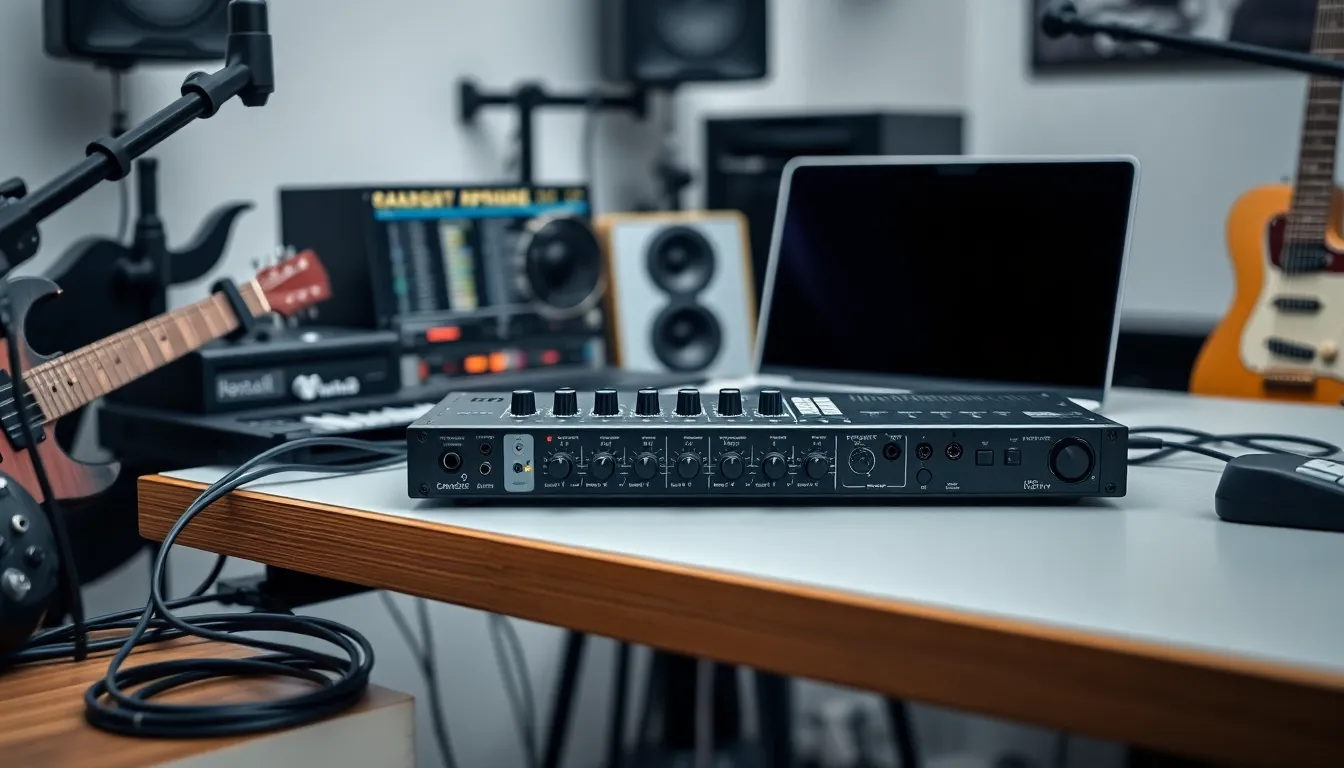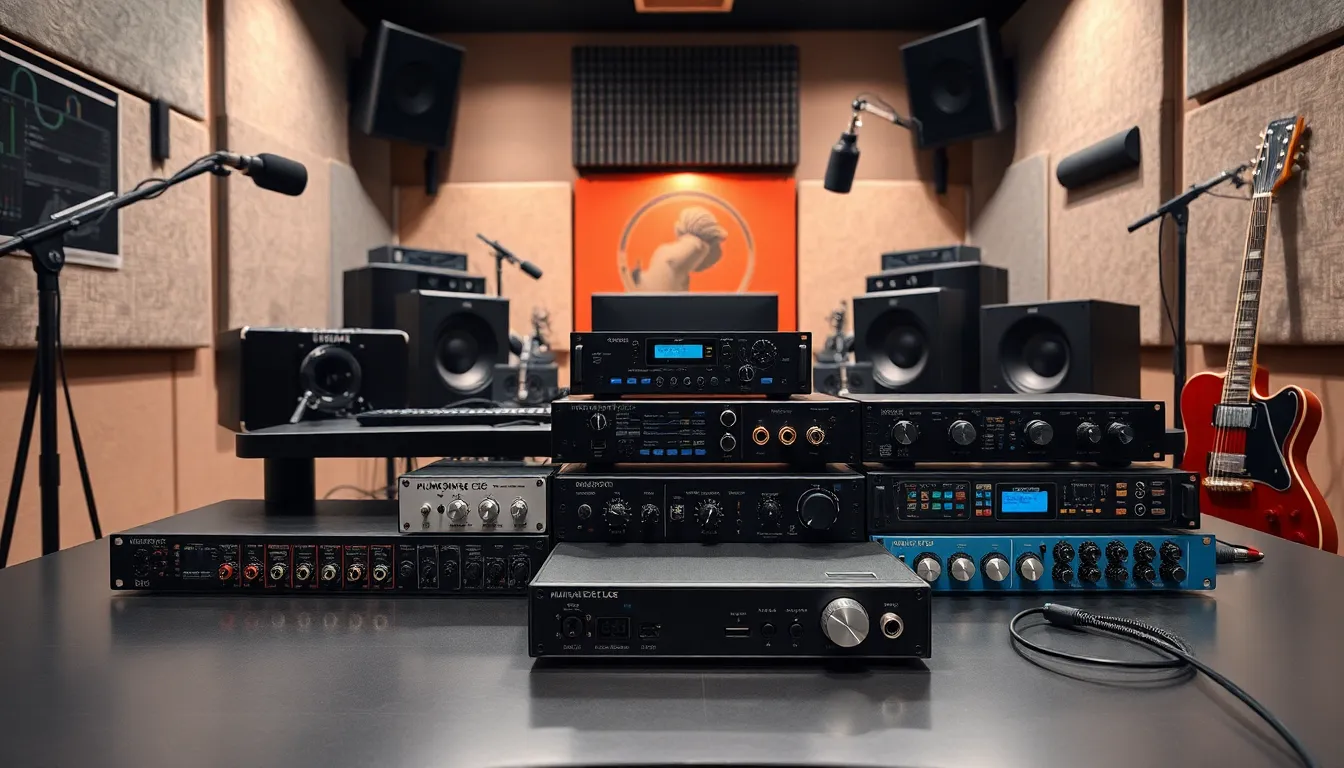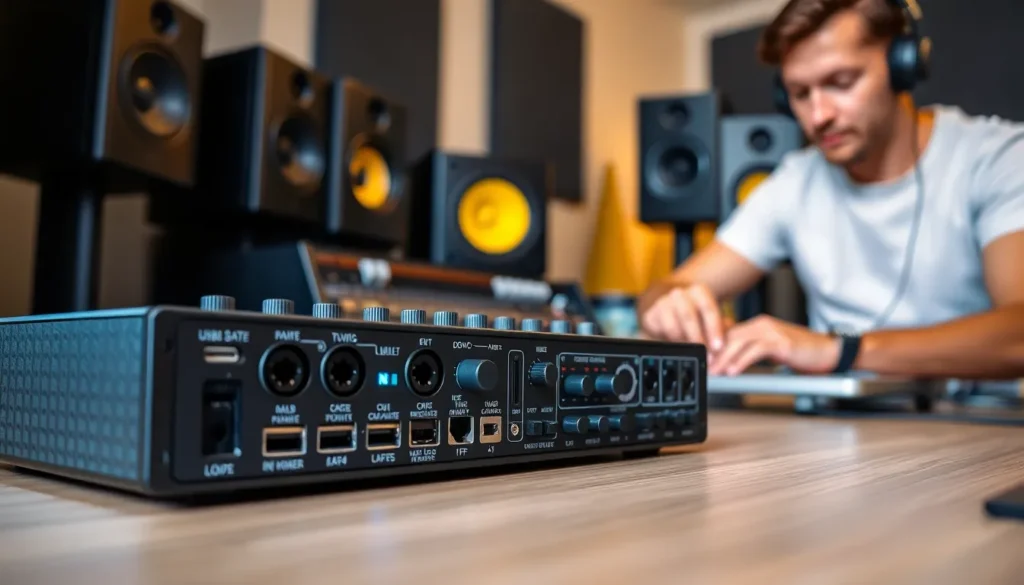In the world of music production and audio engineering, audio interfaces play a crucial role in bridging the gap between the digital and analog realms. These devices transform sound waves into digital signals, allowing musicians and producers to capture high-quality recordings with clarity and precision. With a variety of options available, choosing the right audio interface can significantly enhance the creative process.
Whether you’re a seasoned professional or a budding artist, understanding the features and benefits of audio interfaces is essential. From connectivity options to sound quality, these devices offer a range of functionalities tailored to meet diverse needs. As technology evolves, audio interfaces continue to improve, making it easier than ever to achieve professional-grade results right from home.
Table of Contents
ToggleOverview of Audio Interfaces
Audio interfaces serve as essential tools in music production and audio engineering. These devices convert sound waves into digital signals, enabling high-quality recordings and playback. They bridge the gap between analog instruments, microphones, and digital audio workstations (DAWs).
Key Features
- Connectivity Options: Audio interfaces offer various connectivity options, such as USB, Thunderbolt, and FireWire, catering to different user needs and setups.
- Sound Quality: High-quality AD/DA converters ensure accurate sound reproduction, capturing detailed audio for both recording and mixing sessions.
- Input and Output Channels: Interfaces vary in the number of inputs and outputs, accommodating multiple instruments and microphones simultaneously.
- Preamps: Integrated preamps enhance audio signals, improving overall sound quality by providing the necessary gain for microphones.
Types of Audio Interfaces
- USB Audio Interfaces: Most common type, known for their convenience and compatibility with various computers.
- Thunderbolt Interfaces: Provide faster data transfer rates, ideal for those working with numerous audio tracks or high-resolution recordings.
- FireWire Interfaces: Less common today, but still favored by some users for their stability and low latency.
- Rackmount Interfaces: Designed for studio setups, these options offer expanded connectivity and robust features.
Benefits for Users
- Portability: Many audio interfaces are compact, making them suitable for mobile recording setups and on-the-go musicians.
- Latency Control: They minimize latency issues, allowing for real-time monitoring during recordings and performances.
- User-Friendly Software: Most audio interfaces come bundled with digital audio software, simplifying the recording process for beginners.
Audio interfaces continually evolve, incorporating technological advancements that enhance performance and usability for both novices and seasoned professionals.
Types of Audio Interfaces


Different types of audio interfaces accommodate varying user needs, each offering distinct connectivity and performance benefits. The following sections detail the primary types of audio interfaces.
USB Audio Interfaces
USB audio interfaces serve as the most common choice for musicians and producers. They connect to computers via USB ports, providing widespread compatibility. Key advantages include:
- Portability: USB interfaces are compact and often bus-powered, making them ideal for mobile recording setups.
- Affordability: A wide range of options exists, catering to various budgets without sacrificing quality.
- Multi-channel inputs: Many models support multiple inputs, allowing simultaneous recording of instruments and vocals.
Thunderbolt Audio Interfaces
Thunderbolt audio interfaces offer faster data transfer rates, enhancing overall performance. They are designed for users requiring high-quality audio in professional settings. Notable features include:
- Low latency: Thunderbolt connections reduce latency, crucial for real-time monitoring in recording sessions.
- High channel count: Professional-grade models often support more input and output channels, benefiting larger projects and setups.
- Daisy chaining capabilities: Multiple Thunderbolt devices can connect through a single port, optimizing workspace organization.
FireWire Audio Interfaces
FireWire audio interfaces, though less common, still maintain a presence in some professional environments. They provide reliable data transfer suited for specific applications. Important aspects include:
- Stable connections: FireWire’s technology supports consistent data rates, minimizing audio dropouts during recording.
- Support for multiple devices: Many models allow connections to several peripherals, enhancing studio flexibility.
- Higher performance: Some legacy systems still utilize FireWire for specific hardware compatibility, particularly in established studios.
Each audio interface type caters to distinct user requirements, making it essential to choose one based on specific recording needs and available technology.
Key Features to Consider
Selecting an audio interface requires examining several key features that influence performance and usability. Understanding these elements ensures you choose a device that meets specific needs.
Sound Quality
Sound quality plays a crucial role in audio interfaces. High-quality AD/DA converters enhance sound reproduction, ensuring accurate signal conversion. Look for audio interfaces with a sample rate of at least 24-bit/192 kHz to achieve professional-grade recordings. These specifications allow for greater audio detail and clarity, making them essential for both music production and sound engineering tasks.
Input and Output Options
Input and output options determine how versatile an audio interface can be. Interfaces typically come with a range of inputs, including XLR, TRS, and MIDI ports. A minimum of two input channels is recommended for recording multiple instruments simultaneously. Additionally, multiple output channels facilitate connecting monitors or external effects. Some models may offer built-in preamps to improve microphone signal strength, enhancing overall recording quality.
Latency
Latency refers to the delay between audio input and output. Low-latency performance is critical for real-time monitoring, allowing musicians to hear themselves without a noticeable delay. A latency of under 10 milliseconds is ideal for live recording situations. Look for audio interfaces with efficient drivers and low-latency modes to minimize delay during performance and control.
Compatibility
Compatibility ensures the audio interface integrates smoothly with different devices and software. Check for compatibility with operating systems such as Windows or macOS, as well as popular digital audio workstations (DAWs) like Pro Tools, Ableton Live, or Logic Pro. USB and Thunderbolt interfaces often provide broad compatibility, while FireWire interfaces may require specific adapters or software updates. Prioritize an interface that meets your workflow requirements without compromising system performance.
Popular Audio Interfaces on the Market
Several audio interfaces stand out for their features and performance. Here’s a breakdown of some of the most popular options currently available:
| Audio Interface | Connection Type | Channels | Notable Features |
|---|---|---|---|
| Focusrite Scarlett 2i2 | USB | 2 | High-quality preamps, direct monitoring |
| PreSonus AudioBox USB 96 | USB | 2 | 24-bit/96 kHz recording, bundled Studio One software |
| Universal Audio Apollo Twin X | Thunderbolt | 2 | Real-time UAD processing, premium AD/DA converters |
| MOTU M2 | USB-C | 2 | ESS Sabre32 Ultra DAC technology, LCD screen for monitoring |
| Behringer UMC204HD | USB | 2 | MIDAS preamps, low latency performance |
| Focusrite Clarett 4Pre | Thunderbolt | 4 | Ultra-low latency, ADAT input expansion |
| RME Babyface Pro FS | USB | 2 | High-end converters, extensive software control |
These audio interfaces cater to diverse needs, from basic recording setups to professional studio environments. Each device offers a combination of connectivity options, sound quality, and channel counts, ensuring that users can find an interface suited to their specific requirements.
Choosing an audio interface largely depends on considerations like the number of tracks to be recorded simultaneously, desired sound fidelity, and the type of connection that best fits the user’s equipment. Options such as Thunderbolt and USB offer different advantages in terms of speed and compatibility, catering to both mobile musicians and professional studio applications.
Selecting the right audio interface can significantly impact the quality of recordings and the overall music production experience. With various options available there’s an interface to meet every need whether for a beginner or a seasoned professional. Understanding key features like connectivity options sound quality and latency is essential for making an informed choice.
As technology continues to evolve audio interfaces are becoming more sophisticated enabling users to achieve studio-quality results from their own setups. By considering factors such as the number of inputs required and compatibility with existing equipment individuals can find the perfect audio interface to enhance their creative projects.





